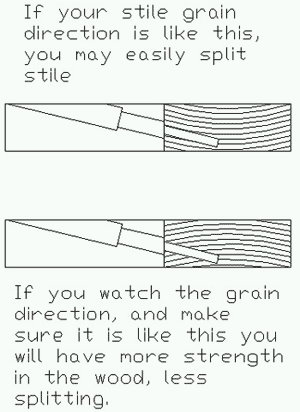Splitting stiles with pocket screws
Other Versions
Spanish
Suggestions are offered on how to overcome the problem. July 24, 2002
Question
I recently started using pocket screws to assemble my face frame stock. I am having a problem with the stiles splitting as I screw the rails to them. I'm using a Kreg jig and a self-drilling, flat head pocket screw. Speed that I'm driving the screw doesn't seem to be a factor, nor does wood type.
Forum Responses
Splitting frames and breaking screws have not been uncommon. S&G Specialty has designed a series of screws for pocket holes to overcome these and other problems. They have a great web site.
On most hardwoods, make sure you are using the fine thread screws. Also, use a drill with a clutch and set the clutch so it slips prior to the wood splitting. Of course, don't screw into end grain, either.
I've used the Kreg jig system for pocket holes for several years as my primary frame assembly method. I mostly use birch, white pine, maple (soft and hard), poplar and occasionally hickory and red/white oak. I order my screws from McFeely's but have used others with similar success. I used to use the fine threaded screws for hardwoods and the coarser ones for softwoods, but because I seem to have a habit of running out of one or the other, I now stock the ones that are dual purpose (hard and softwoods) for use with both species. I always prepare my screws by scraping their tips into paraffin wax (usually a large candle). I do this with every type of screw that I am going to run into hardwood if I have not provided a pilot hole (as when screwing into stiles during face frame assembly). That doesn't do much to help splitting, but it definitely helps reduce the force required and friction produced when driving screws.
You should not be having problems splitting the stiles out, except when attaching top and bottom rails to the very ends of the stiles. I use 1-3/4", 2", and 3" rails to produce my framed cabinets (depending on cabinet and rail location). First, you should try and keep your outside hole (the one that you drill in the rail, which will end up being closest to the end of the stile) as far away from the end as practical.
Here's what I do to keep from splitting the ends of stiles - drill the screw into the stile with *very* short bursts of trigger pull, allowing a short (about half a second) pause between bursts - zip, zip, zip, zip, zip, zip, zip, until the screw is fully seated. It's rare for the stile to split out using this method - try it, even though you said that it doesn't matter what speed you drive the screws, it does matter at what pace (or cadence) you drive them. It also helps to use extra heavy clamp pressure (centered right over the screw you are inserting) with the Kreg frame clamp – but the real trick is the short bursts!
Rather than flat head screws, you should be using pan head screws - then just snug them up.
Pan heads are good, except that the washer head was developed for jigs that use drill bits (Kreg), while the pan heads are for machines that use routers, such as Castle. Kreg does now have a flat bottom drill bit, but flat is a relative term and the high-speed, very flat router does prepare the hole differently. The type 17 point plus the Quickcutter flute will stop the splitting and the thread count and other features will make a difference overall.
I don't think I've ever split a stile with Kreg's washer-head fine thread screws. I have split a few rails when I went too fast.
We use the Kreg jig and never split any wood. We also use a set of vise grips with the quarter-like pads on the ends to clamp the pieces together while screwing. This does a good job getting the two pieces even and saves time in sanding.
It could have to do with the grain direction on your stile. I have found that with oak, if you don't watch which way the grain cups, you have a better chance of splitting.

The comments below were added after this Forum discussion was archived as a Knowledge Base article (add your comment).
Comment from contributor A:
Try setting the depth of your jig shallower and using no more than 1 1/4" screws. I also use fine thread for hardwoods such as oak, maple, and hickory, and coarse thread for pine and the like.
Editor's Note: If you need specialized machinery for inserting hinges or pocket holes, look at the offerings from J&P Machines (website)!
